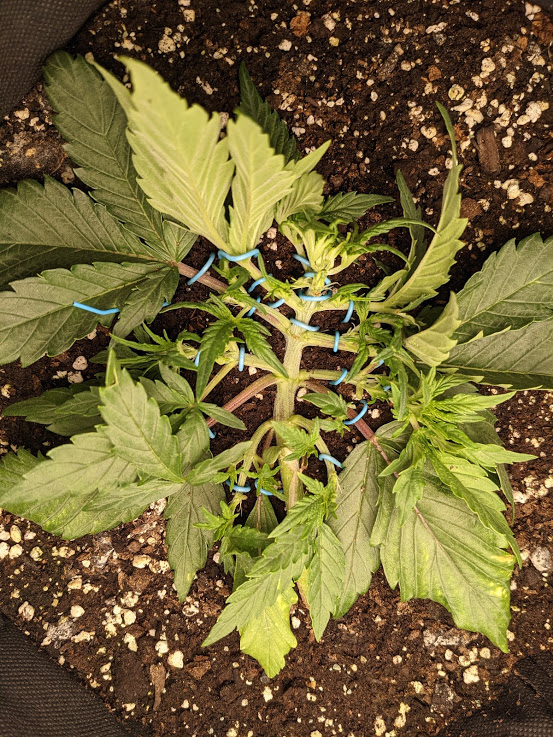The main concept of training a plant is to shape the canopy and stems in a way that will maximize yield. For example, without training, the upper canopy can have fan leaves that shade bud-producing stems. Via training it is possible to force lower branches to grow away from more dense areas to receive more light and airflow; this allows the plant to be more open, giving each branch more growing room and a chance to branch further.
Low Stress Techniques (LST)
LST can be applied as soon as the plant has one node, as this is when it is flexible and not brittle. One of the best options with LST is to try to make the main stem grow sideways so that most of the branches aren't in the shadow of the main canopy, as they would be if the canopy was directly above. LST can be applied throughout the plant's entire lifespan.
It may be necessary to adjust your LST every day or every two days when the plant is growing quickly
Fluxxing
Paper clips can be used to pin the stem down as it grows. This greatly reduces the height of the plant by training branches to grow laterally. This method is better suited to more compact mediums like soil, as pins require some friction to stay in place. Pinning should start as soon as there is a long enough stem to pin. You can grow a seedling in low light to increase the stem stretching in the seedling phase. This can increase the inter-nodal distance, giving your branches more space later on in flowering.

Here, the plant is kept low to the soil with blue paper clips. See how the clips can be used to twist the main stem as it grows so that all nodes can emerge parallel to the soil
Using plant tying wire
Tying wire is usually a stiff metal wire coating in soft plastic. It can be wrapped around stems and used to hold others in place without cutting into the stem as well as being tied through holes in the side of the pot.
Ponytailing
Ponytailing is the process of tying leaves up in a bunch together to remove the shade they create. This also leads to the ponytailed stem receiving less light and stretching more as a result. This can be done with small cable ties or paper clips.
Defoliating
Defoliating is simply the process of removing excess leaves. If there are too many leaves, the humidity can become too high and fan leaves that do not create buds can shade other branches that will bear buds. Take care not to prune excessively once the plant is a few weeks into flowering, as the leaves will not regrow, negatively impacting yield.
Lollipopping
This is the process of stripping all small buds and leaves from a branch except those at the top of the canopy so that the branch resembles a lollipop. The idea is that the plant will spend more resources on the cola at the top of the stem, as less is wasted on small "popcorn" buds that will not yield much as they are in the shade of the canopy. This technique is more suited to photo flowering strains, as they have more time to recover from the process. Alternatively, smaller buds can be left to continue growing after an initial harvest of the main colas, until they are mature enough for a second harvest.
Screen of green (ScrOG)
ScrOG or Screen of Green is a training method where a large trellis (a.k.a mesh, screen, net) is placed over the cultivar so that the branches can be more easily shaped to form a flat canopy. This technique is often paired with mainlining.
Sea of green (SOG)
A method of planting a large number of plants so that there is a high density of cultivars under a trellis.
==High Stress Techniques (HST)==.
Topping
Removing the growth at the top of a branch. This can be used to create two new heads at the top of the branch.
Mainlining
By topping the main stem, one can create a manifold ('Y' shaped stem). This forces the plant to split resources between the remaining branches, creating a more even canopy. This should be done when the plant a) has at least three nodes, b) when it is healthy and c) while it is still vegetating. After creating a manifold, LST should be applied to maintain the shape of the plant.